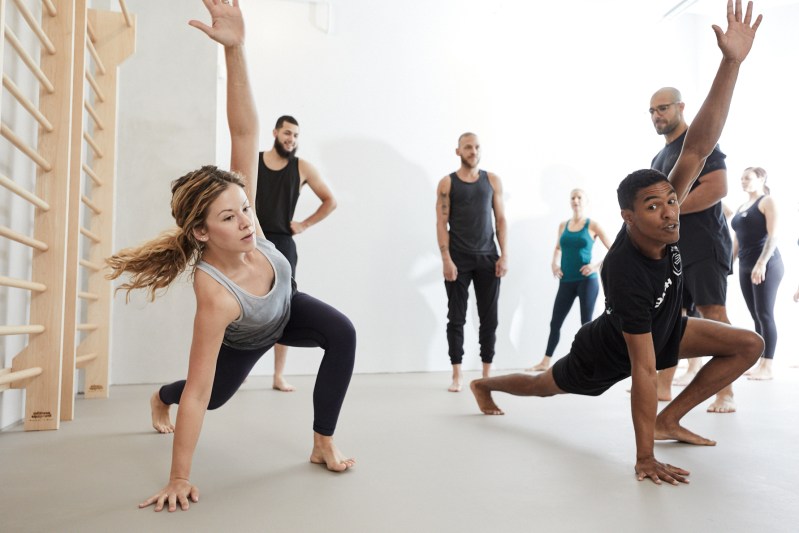
It’s January, and even if you don’t believe in New Year’s resolutions, it’s still a perfect time — now that the holidays are behind us and there’s nothing but the cold grind of winter ahead — to focus on getting our bodies into better shape. If the start of a new decade has you thinking about changing things up with your workout, you’re not alone. The latest fitness trend isn’t about how many reps you can finish or how much weight you can lift. The “movement” trend calms everything down and brings it back to basics. This practice, which incorporates elements of gymnastics, dance, and martial arts, leads to fewer injuries and a better workout form in general.
Veteran trainer and workout coach Will Torres of New York City’s Willspace has not only been influential in developing some of these new fitness protocols into the regular routine of his private clients (who include celebrities, titans of finance, and tech execs), but he has also moved from focusing solely on exclusive one-on-one training sessions to offering this unique approach in a group class format. We sat down with Torres for a master class on the newest
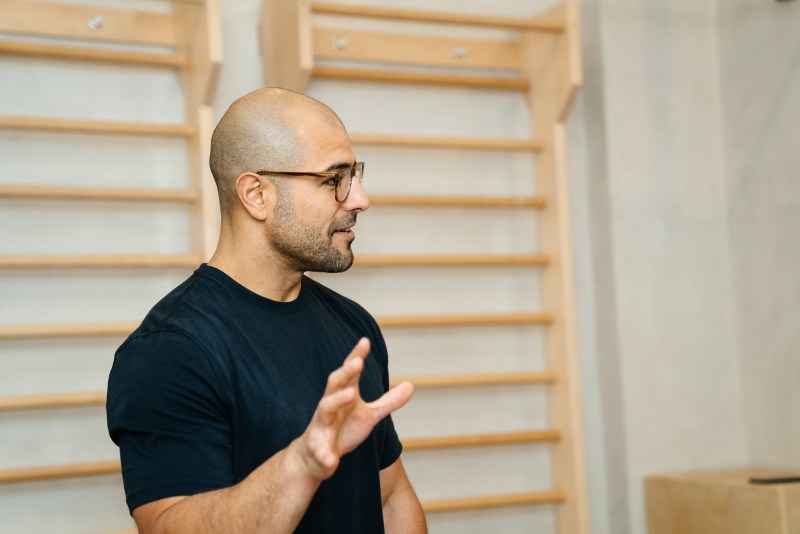
Torres himself looks like a cross between your favorite college professor and a local beat cop. There’s a quiet intelligence that lies behind his friendly and expressive face, but you can tell by the way he moves that the body beneath is an almost feline expression of pure power and strength.
What sets this practice apart from, say, a CrossFit, Orange Theory, or any group fitness class at your local gym?
“CrossFit and Orange Theory deal with quantifiable targets,” says Torres. “Their aims are very specific and, for the most part, lack proper preparation methods. Our movement approach is geared toward improving the function, strength, and flexibility of the entire body through non-traditional methods. We have ways of getting stronger without lifting a weight and ways of improving endurance and conditioning without using a bike or a treadmill.”
Torres and his team’s focus is on developing their students as generalists, allowing them to be introduced to many movement concepts and challenges, many of which cannot be quantified. With time and enough practice, pupils are built up to be “movers,” surpassing even their own perceptions of what is possible.
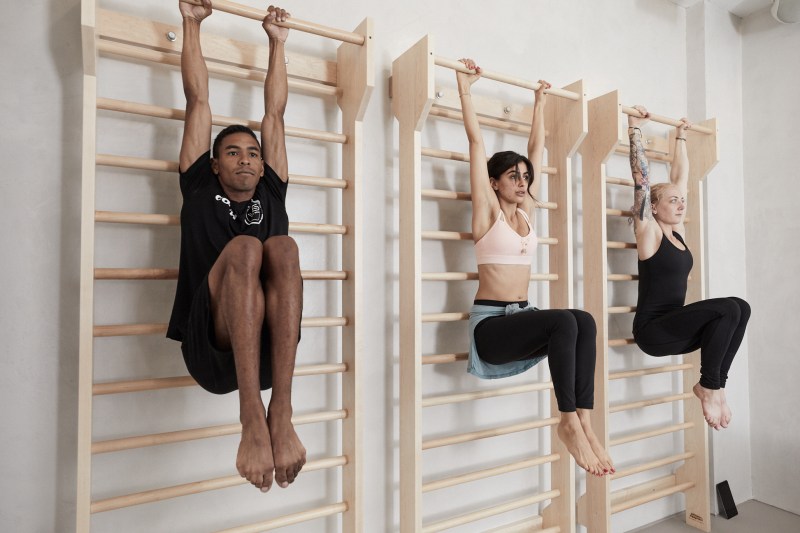
“Learning new movement tools is a huge foundation of our practice, which means that we are continually introducing our students to new drills and tools that will help them to expand their movement capabilities. This means that we are not focused on traditional lifts like squats and deadlifts nor repetitive exercises like bicep curls or sit-ups.”
Attendees may feel almost like they are back in an elementary school gym class, lined up and sometimes partnered, moving through some very simple — but very challenging — exercises. In the class that I attended, we went through crab-like, sideways walking movements; subtle variations on plank positions, and controlled hanging from wall-mounted Swedish Ladders. Each move was carefully inspected by the coaches to be sure we were maintaining proper form throughout the movement’s duration.
Torres points out that the topic with the largest amount of online searches about fitness is “‘what to do for lower back pain after weightlifting.’ This is another example of people focusing only on weight or intensity without learning proper technique or proper preparation for the movement. For example, we will never add weight to someone’s squat unless they can demonstrate to us that they can maintain a deep squat position for 10 minutes. Nor will we introduce a deadlift to someone that cannot touch the floor with their legs completely straight. Our moves will be challenging in the beginning, but are quite worthwhile in the end. They are all accessible for all levels of
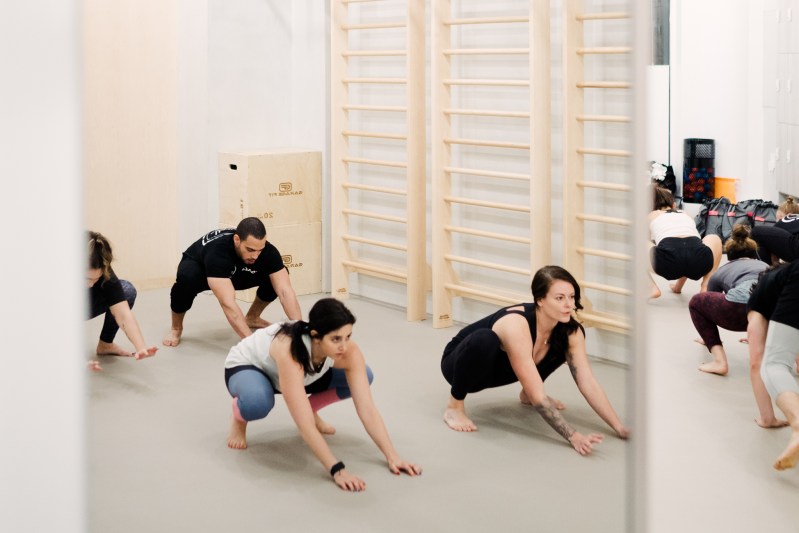
I shared my personal concerns with Torres (like a lot of guys who aren’t necessarily into yoga or a regular stretching program) about whether not being particularly flexible would interfere with my taking a movement class.
“Actually, if you are not flexible, our approach is ideal for your body type. Flexibility is the most misunderstood element within fitness. It’s important to note that all movement creates movement. If you move with improper technique you will condition the body to move in an inefficient way. What does it matter if you get a chiropractor to realign your body if you go back to moving in a way that creates misalignment?
“One of the main reasons certain motions are hard for people is because they are tight. Then the tightness keeps them from trying or pursuing new motions. For example, many people suffer with shoulder pain. The best thing for this is hanging. Yes,” Torres affirms, “basically just grabbing a bar and allowing gravity to stretch the shoulder. Hanging also has many other benefits that are not obvious: it also helps with lower back issues.”
Let’s get serious, though: beach season will be here in a maximum heartbeat, but while some of us have to worry about how we’re going to look in a swimsuit; others wonder if we’ll be able to carry a two-year-old and a stroller up a flight of steps on our own.
“There are many benefits to our movement approach,” Torres points out, “however, the goal of weight loss or building muscle is not where our practice is based. We are developing our students to be extraordinary movers.
“Do you know how many people sign up to do a marathon to lose weight and come out on the other side with tendonitis, knee pain, and weight gain? Or how many people focus on bigger arms for years by doing bicep curls and tricep kickbacks, while never gaining an inch in the arms … but instead develop ‘tennis elbow,’ never having played a day of tennis in their lives? These types of goals are insanity provoking. Mainly because people set them and then pursue them with old training tactics. Becoming a better mover is a never-ending process. One day you are doing handstands, the next, backbends and one-arm hangs. One morning you’re working on middle splits; and in the evening, boxing. One afternoon you’re working on your squat, and later that day on crawling patterns. By focusing on learning new concepts and attempting new movement challenges, you will experience far more benefits than weight loss and muscle gain.”
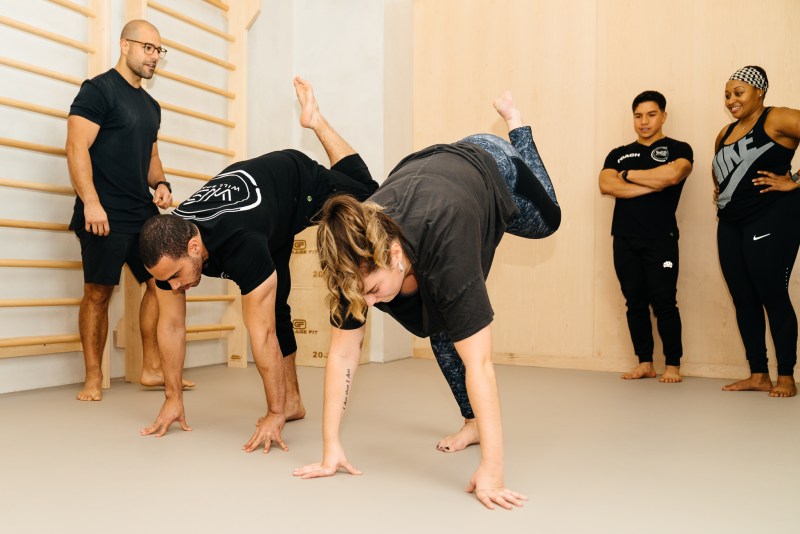
So if I’m working on these movement exercises, I asked, will I need to supplement it with aerobic exercise, like running?
“This question is rooted in decades of misinformation,” says Torres. “What happens when running no longer provides the benefits it once did, but rather now contributes to incredible pain and discomfort? We are still wired to believe that 30 minutes of cardio, three times per week is an ideal prescription for weight loss. We still believe that we can get a good workout in 20 minutes. This is all hogwash. If you are a couch potato then doing anything is better than nothing. However, when you do enough of this, then you will need to do more to make progress. Many of our students start with three to four hours per week and, over time, increase to 10 to 12 hours by expanding their movement practice. There are many elements within our movement practice that challenge the cardiovascular system far better than running, walking, or cycling. Our students become better conditioned without all the nagging overuse injuries and limitations that isolated endeavors offer, all while becoming stronger and more flexible at the same time.
I also asked what a first-timer might expect from his first class?
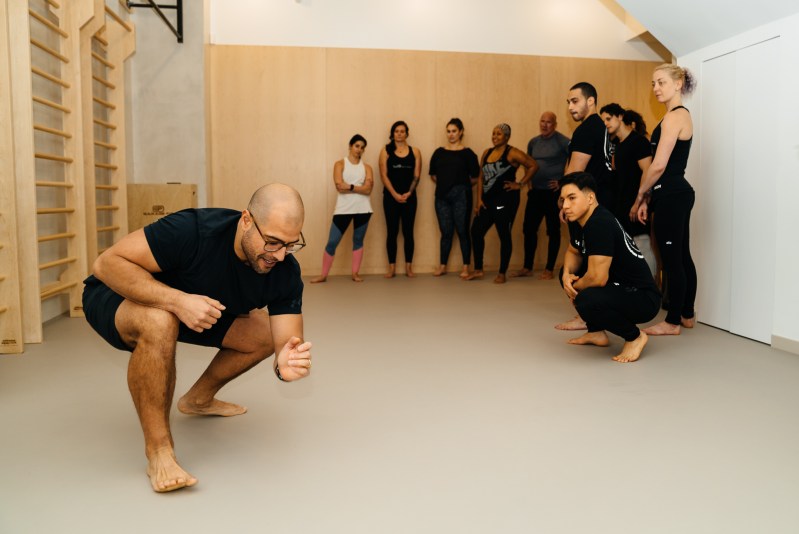
“Your first class will be mind-blowing. Many of our students leave saying that they thought they were doing things right until now. Many students say, ‘I’ve been doing planks wrong for years. I’ve never done a plank like this before. I feel the difference,’ and ‘My legs are shaking. I run six miles a day but my legs have never felt like this before. This is incredible!’ ‘I’ve worked with a lot of trainers but I have never worked with anyone that is so precise. My trainer normally just lets me do my exercises however I want, but you guys don’t play around.’”
Speaking from the experience and as somebody who’s in reasonably good shape for my age, I was surprised at how much I was sweating at the end, and how well “worked-out” my body felt the next day. Doing the class with others also added a level of intensity with both a bit of healthy competition and camaraderie as we cheered each other on.
“We teach our students how to move better and how to get the most out of their movement practice,” says Torres. “We move with the lights on. We are not a bootcamp and we don’t do ‘workouts.’ To become a better mover, you must do research, and since most people have never stopped to ask the right questions, we introduce them to what we have found to be the most relevant protocols and tools. After one class you will leave feeling great. You will feel different parts of your body the next day, but won’t feel crushed. Most importantly you will want to do more. After a month you will begin to leave behind many of your old training concepts. After three months, your friends will ask you what you have been doing, because they will see the difference. After four months, your physical therapist, chiropractor, and massage therapist will all write you wondering where you have been. Because you have been moving better, there are no more tweaks, aches, or pains. You will respond, ‘I’m great. Thanks for checking in.’”
Of course, if you don’t live in New York City, don’t worry, fitness studios offering movement classes, including Loco Motion New York on Long Island, and Boulder Movement Collective in Colorado, are cropping up across the country.



